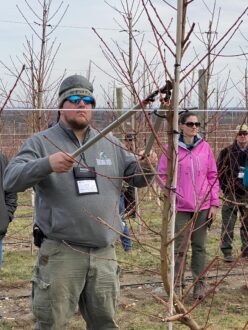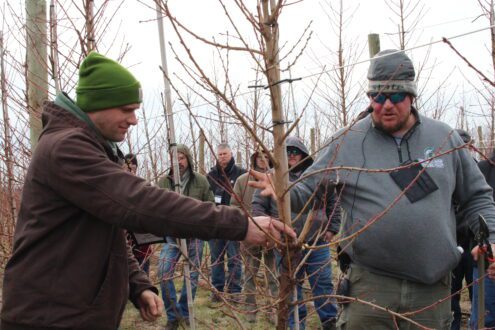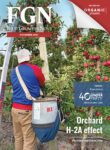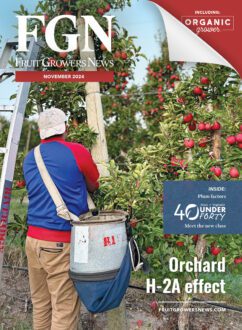Mar 13, 2023Peach V-system reduces labor, increases yield
Jake and Nick Rasch are sixth-generation fruit growers who are putting their own spin on new technologies and orchard training systems on their more than 500-acre operation on West Michigan’s famed Fruit Ridge.
Tour visitors from the International Fruit Tree Association’s (IFTA) annual conference in Grand Rapids, Michigan, in February were shown a block of Bellaire peaches planted in 2020 on Bailey rootstock at Rasch Family Orchards.
The in-row, V-system peach blocks have produced more uniform-sized fruit, and the number of peach pickings has been reduced from eight or nine down to five or six.

Using plant-growth regulator Accede (1-aminocyclopropane-1-carboxylic acid) has further reduced pickings down to four or five, with less mixed maturity and more fruit per harvest. The Rasch brothers now anticipate an average harvest of 500 to 650 bushels per acre, depending on variety.
When IFTA visited the Rasch’s Coulter Farm in summer 2017, there was a viewing of two trial rows of in-row V peaches. Since then, Rasch Family Orchards has planted three full orchards of in-row V at 12 by six feet (1,210 leaders per acre).
“We’ve been getting good production on the perpendicular V, but on this in-row V, I’m getting better-quality fruit,” Jake Rasch said. “What we did was, with first-year nursery trees that we headed and let the tree grow. We picked two leaders, had my crew come through and start on the end with a three-foot stick, to place a piece of bamboo every three feet.”
With leaders at three-foot intervals, Jake Rasch said he wasn’t overly concerned about tree spacing.
“In my trial rows, the trees were five feet apart. They were a little bit close, but I didn’t measure exactly like I did here,” he said. “This is 12 foot by six. What was easy about this is we already had all the apple equipment to chop, weed and spray a 12-foot row.”
In the trial rows Rasch had a perpendicular V, but chose an in-row V for new production.
“We cut a few pickings out because we got better quality,” he said. “That’s a huge labor savings. Peach trees are nothing but a labor pool. We will try hedging them, probably for summer pruning. I would never do it for dormant pruning because I don’t want to invigorate them.”
Although the majority of the acreage is pruned in the summer, winter pruning is when the Raschs perform renewal cuts and clean them up, Nick Rasch said.
Summer 2022 was the first crop with the new orchards, bringing about 100 bushels to the acre, and hopes are for 300 bushels this coming season, he said.
The in-row site is a little sandier than the farm’s other peach site.
“We did do a little fertigation when the trees were young to help them grow the first two years,” Nick Rasch said. “Now we will go to strictly ground-applied fertilizer now that the root zone is grown in.”
For a decade, the farm used string thinners for blossom thinning, but has trialed Accede for five years and it’s now used for all blossom thinning.
“Part of our game plan this year is that like on our Red Havens and Bellaires that are not heavy-setters, we’ll spray them one time at early bloom with 300 parts of Accede, Nick Rasch said. “We do it at 100 gallons an acre, putting two-thirds of the dope on the top half of the tree as you do on apples. They will thin harder on the top than on the bottom of the trees.”
Varieties with a heavier fruit set, such as Allstar and Starfire, receive another application at full bloom.
“What we’ve found on heavy-setting years is that we’ll save about 50% on our labor on hand thinning,” Nick Rasch said. “You get better fruit size and more of a condensed harvest with Accede. That’s what we’re really excited about for the future.”
Rasch said they also are trying to achieve labor savings with such systems.
“Hopefully, we can reduce our pruning costs and increase harvest efficiency with fewer pickings and make it easier to reach through the tree,” he said. “That’s our main goal — try to cut labor costs and have better fruit quality.
Not always perfect
When planting the orchard, Jake Rasch said the planter was set at six feet intervals.
“The guy on the planter doesn’t get it all right every single time,” he said. “We started on the end. I told him where I wanted the first leader and just marked out three feet all the way down. It doesn’t matter if the tree is there or not because I wanted just a uniform number, every three-foot space down to be a leader.
“I don’t care if there’s three leaders or two, it will fill, it will be fine,” he said. “The other side will catch up. My trial row actually has a tree or two that are three leaders, just because of the spacing.”
The perpendicular trees are 11 to12 feet high on a 15-by-5-foot plant spacing.
“I would say it’s no different than apples. They’ll be 11-foot,” Jake Rasch said. “Most people only have six feet of production on peaches. This is going to have nine feet of production and I believe I will continue to keep nine feet.
“I have good light here all of the time,” he said. “When it was the other way, I was shading the bottoms too much and that’s where I had smaller fruit and it took longer for the fruit down there to color up. It was so much mixed maturity.”
Peach production in the perpendiculars produce about 1,000 leaders an acre. The in-row V sports1,200 leaders per acre.
“With the extra leaders per acre and having a fruiting wall, where the other way may have 400 bushels per acre, we may be pushing 600 bushels per acre, depending on the variety,” Jake Rasch said. “If you planted Allstar on this, I bet you could get 1,000 bushel an acre on a really good year. I have seen 800.”
Pruning exercise
Turning to a traditional IFTA pruning demonstration, Jake Rasch explained that “what I would do is when we summer prune this August, we want to head these to keep them mellow. If we did too much in July, it invigorates the tree so in the winter it wouldn’t calm down. I would just get rid of all of the big stuff on this leader so they’re all going to try to be the same height.”
With the in-row model, light is available all morning and afternoon, Jake Rasch said.
“Typically, close to the bottom they tend to die out,” he said. “That’s why people tend to have six feet of production. I’m keeping eight to nine feet of production.”
Jake Rasch said he will run his platform through the rows and hand-thin the tree tops.
“It will just be a cleanup,” he said. “It’s not doing a full-blown job that you need to stop here with the ladder. It will be, ‘Hey, here’s some clusters.’ I’ll just break that up and keep going.”
Vigor control
Michigan State University horticulture professor Greg Lang told the Rasch brothers he agrees with their methods, but might opt for leaders every two feet instead of three.
For each climate and variety, growers should base leader spacing by sunlight needs, Lang said.
“Is it three feet for the leaders per row, is it 2½ feet, is it 20 inches?” he said. “You should strive to always have that same spacing. What that means is you’re capturing light as appropriately as possible to maximize your yield.”
The university is trialing semi-vigorous and semi-dwarfing rootstocks, Lang said.
“If it’s a Lovell (rootstock), if it’s a Bailey, you’re going to have to plant those trees farther apart to put another leader or two on them,” he said. “If you’ve got access to a semi-vigorous or semi-dwarfing, you plant those trees a little bit closer together. Ultimately, you’re going to find the ultimate spacing.
“That spacing of the leaders should always be the same. Then you manipulate how many of those leaders relative to what that rootstock and the nature of the soil is.”
Nick Rasch pointed to a three-leader growth, noting that its diameter is a little larger than that of a two-leader growth.
“You want your one-year-old wood to look like this at the end of the year because you’ve got good, healthy buds,” he said. “You’ve got a strong caliper wood there that’s going to support that crop for the next year. We don’t want to run them out too far. We’re not getting that growth for the next year’s crop. If we had a controlling one and you could just put single-leader trees in here it would be a good way to go.”
They planted the trees straight up to avoid the cankering, winter injuries and higher tree mortality they see with older plantings with limbs that were too horizontal.
“With a tree structure like this (in-row V) we see that the longevity of the tree is better,” Nick Rasch said. “That’s why we didn’t tip trees. We just went standard, straight up and down and sent some leaders out.”
Marketing
“The peach market’s down 50% in the last so many years,” Nick Rasch said. “As an industry we owe it to ourselves to only put good fruit out there.”
Varieties with great flavor and size are available, he said, with harvest dates that extend through the season.
“You can get a little market share back if we all do it right,” he said.
While the Rasch’s sell some of their peaches to local farm markets and fruit stands, the majority of them go through their apple packing line to be sold at supermarkets. Fifty acres of peaches is too much production to do it all through farm market and fruit stands, Nick Rash said.
— Gary Pullano, FGN Senior Correspondent
Top photo: The in-row V-peach planting system produces more uniform fruit sizes and reduces peach pickings. Jake Rasch demonstrates pruning during the field tour. Photos: Gary Pullano
Second photo: Jake and Nick Rasch exhibit an in-row, V-system peach block during the International Fruit Tree Association’s annual conference.















